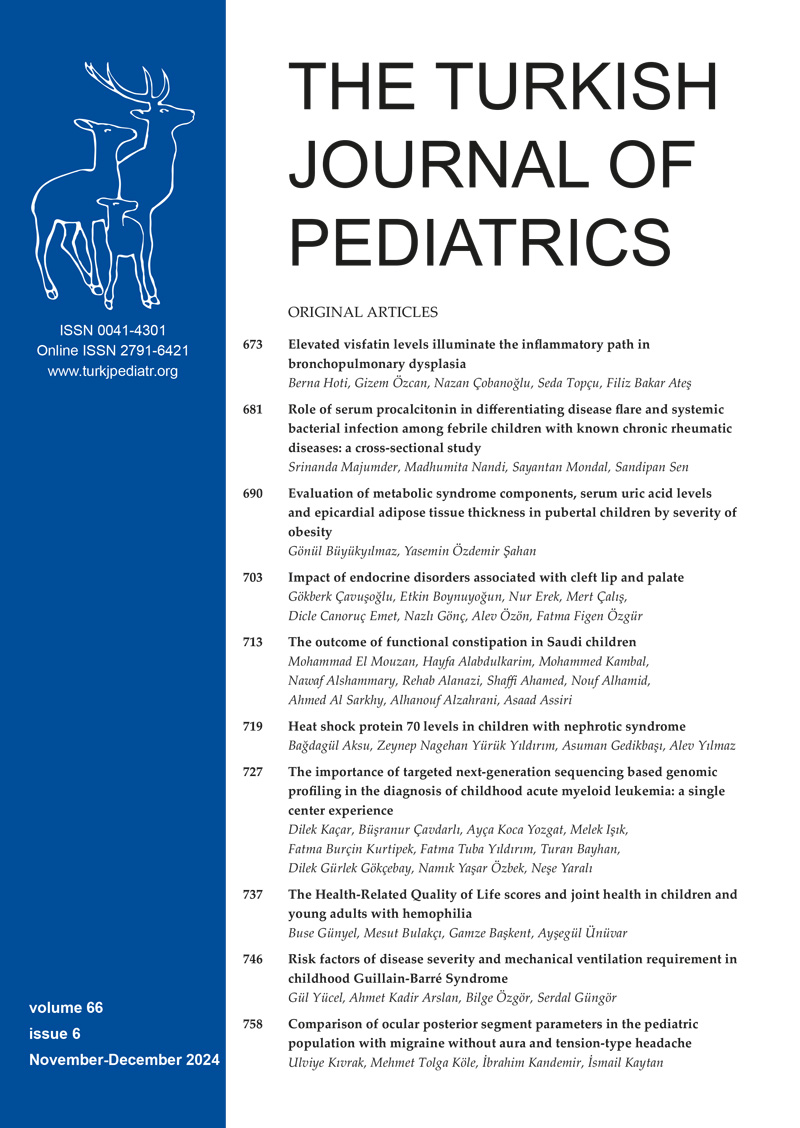Abstract
Background. Patients with hemophilia should be evaluated for joint health and overall health in their visits. The aims of this study were to evaluate joint health and health-related quality of life (HRQoL) in patients with mild, moderate, and severe hemophilia; determine which patient groups to focus on and whether there are any neglected patient groups.
Methods. This was a single-center, cross-sectional study. Patients were evaluated by ultrasonography (Hemophilia Early Arthropathy Detection with Ultrasound [HEAD-US]), physical examination (Hemophilia Joint Health Score version 2.1 [HJHS-2.1]), and HRQoL scales (EQ-5D/EQ-VAS and Haemo-QoL).
Results. Thirty-nine patients with regular follow-up were evaluated for a total of 234 joints. When hemophilia severity was compared with the HEAD-US and HJHS-2.1, a significant difference was found between severe and non-severe hemophilia. On the other hand, when patients’ total HEAD-US scores were compared with total HJHS-2.1 scores, no statistically significant correlations were found; only a statistically significant but negligible correlation was detected when HEAD-US and HJHS-2.1 scores were examined at joint level. No significant difference was found when mild, moderate or severe hemophilia were compared with the HRQoL scores. Also, HEAD-US scores and HRQoL scores were not correlated, showing that the HRQoL score did not change whether the patient has arthropathy or not.
Conclusion. Despite recent advances in treatment options for hemophilia, arthropathy in patients with severe hemophilia remains challenging. For the follow-up of pediatric hemophilia, the HEAD-US and HJHS should be used together because their correlation was weak. Although patients with severe hemophilia are at higher risk in terms of arthropathy, patients with mild/moderate hemophilia should not be ignored because their HRQoL is not different from that of severe hemophilia.
Keywords: hemophilia, hemophilic arthropathy, health-related quality of life, HJHS, HEAD-US
References
- Srivastava A, Santagostino E, Dougall A, et al. WFH Guidelines for the management of hemophilia, 3rd edition. Haemophilia 2020; 26(Suppl 6): 1-158. https://doi.org/10.1111/hae.14046
- Santagostino E, Fasulo MR. Hemophilia a and hemophilia B: different types of diseases? Semin Thromb Hemost 2013; 39: 697-701. https://doi.org/10.1055/s-0033-1353996
- Castaman G, Matino D. Hemophilia A and B: molecular and clinical similarities and differences. Haematologica 2019; 104: 1702-1709. https://doi.org/10.3324/haematol.2019.221093
- Oldenburg J. Optimal treatment strategies for hemophilia: achievements and limitations of current prophylactic regimens. Blood 2015; 125: 2038-2044. https://doi.org/10.1182/blood-2015-01-528414
- Abdi A, Kloosterman FR, Eckhardt CL, et al. The factor VIII treatment history of non-severe hemophilia A. J Thromb Haemost 2020; 18: 3203-3210. https://doi.org/10.1111/jth.15076
- Fischer K, Poonnoose P, Dunn AL, et al. Choosing outcome assessment tools in haemophilia care and research: a multidisciplinary perspective. Haemophilia 2017; 23: 11-24. https://doi.org/10.1111/hae.13088
- Martinoli C, Della Casa Alberighi O, Di Minno G, et al. Development and definition of a simplified scanning procedure and scoring method for Haemophilia Early Arthropathy Detection with Ultrasound (HEAD-US). Thromb Haemost 2013; 109: 1170-1179. https://doi.org/10.1160/TH12-11-0874
- Hilliard P, Funk S, Zourikian N, et al. Hemophilia joint health score reliability study. Haemophilia 2006; 12: 518-525. https://doi.org/10.1111/j.1365-2516.2006.01312.x
- St-Louis J, Abad A, Funk S, et al. The hemophilia joint health score version 2.1 validation in adult patients study: a multicenter international study. Res Pract Thromb Haemost 2022; 6: e12690. https://doi.org/10.1002/rth2.12690
- Gouw SC, Timmer MA, Srivastava A, et al. Measurement of joint health in persons with haemophilia: a systematic review of the measurement properties of haemophilia-specific instruments. Haemophilia 2019; 25: e1-e10. https://doi.org/10.1111/hae.13631
- EuroQol Group. EuroQol-a new facility for the measurement of health-related quality of life. Health Policy 1990; 16: 199-208. https://doi.org/10.1016/0168-8510(90)90421-9
- von Mackensen S, Bullinger M; Haemo-QoL Group. Development and testing of an instrument to assess the quality of life of children with haemophilia in Europe (Haemo-QoL). Haemophilia 2004; 10(Suppl 1): 17-25. https://doi.org/10.1111/j.1355-0691.2004.00875.x
- von Mackensen S, Gringeri A, Siboni SM, Mannucci PM; Italian Association of Haemophilia Centres (AICE). Health-related quality of life and psychological well-being in elderly patients with haemophilia. Haemophilia 2012; 18: 345-352. https://doi.org/10.1111/j.1365-2516.2011.02643.x
- Jiménez-Yuste V, Álvarez-Román MT, Martín-Salces M, et al. Joint status in Spanish haemophilia B patients assessed using the Haemophilia Early Arthropathy Detection with Ultrasound (HEAD-US) score. Haemophilia 2019; 25: 144-153. https://doi.org/10.1111/hae.13628
- Fang Y, Guo Y, Qin T, Luan Y, Zhang C. The correlation between the HEAD-US-C score and HJHS in hemophilic arthropathy of the knee. J Ultrasound Med 2023; 42: 859-868. https://doi.org/10.1002/jum.16072
- Xu RH, Dong D, Luo N, et al. Evaluating the psychometric properties of the EQ-5D-5L and SF-6D among patients with haemophilia. Eur J Health Econ 2021; 22: 547-557. https://doi.org/10.1007/s10198-021-01273-5
- Baek HJ, Park YS, Yoo KY, Cha JH, Kim YJ, Lee KS. Health-related quality of life of moderate and severe haemophilia patients: results of the haemophilia-specific quality of life index in Korea. PLoS One 2020; 15: e0238686. https://doi.org/10.1371/journal.pone.0238686
- Oldenburg J, Tran H, Peyvandi F, et al. Health-related quality of life and health status in adolescent and adult people with haemophilia A without factor VIII inhibitors-A non-interventional study. Haemophilia 2021; 27: 398-407. https://doi.org/10.1111/hae.14270
- Chai-Adisaksopha C, Noone D, Curtis R, et al. Non-severe haemophilia: Is it benign? - Insights from the PROBE study. Haemophilia 2021; 27(Suppl 1): 17-24. https://doi.org/10.1111/hae.14105
- Cheung YT, Lam PH, Lam HHW, et al. Treatment adherence and health-related quality of life in patients with hemophilia in Hong Kong. Int J Environ Res Public Health 2022; 19: 6496. https://doi.org/10.3390/ijerph19116496
- Daffunchio C, Landro ME, Galatro G, et al. How mild is mild haemophilia? Haemophilia 2023; 29: 530-537. https://doi.org/10.1111/hae.14750
- Foppen W, van der Schaaf IC, Beek FJA, Mali WPTM, Fischer K. Diagnostic accuracy of point-of-care ultrasound for evaluation of early blood-induced joint changes: comparison with MRI. Haemophilia 2018; 24: 971-979. https://doi.org/10.1111/hae.13524
- Måseide RJ, Berntorp E, Astermark J, et al. Haemophilia early arthropathy detection with ultrasound and haemophilia joint health score in the moderate haemophilia (MoHem) study. Haemophilia 2021; 27: e253-e259. https://doi.org/10.1111/hae.14245
Copyright and license
Copyright © 2024 The Author(s). This is an open access article distributed under the Creative Commons Attribution License (CC BY), which permits unrestricted use, distribution, and reproduction in any medium or format, provided the original work is properly cited.















